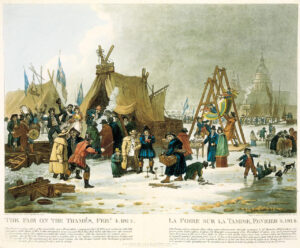Imagine stepping onto the frozen surface of the River Thames, not cautiously inching forward, but striding confidently past roaring bonfires, puppet shows, and stalls selling roast beef and gingerbread. This was not a scene from a fantasy novel, but a very real part of London’s history. Between the 17th and early 19th centuries, a series of extraordinary events called the Frost Fairs turned the River Thames into a bustling winter festival ground.
The Birth of the Frost Fairs
The Frost Fairs were a direct result of a climatic phenomenon known as the Little Ice Age, a period of unusually cold weather that gripped Europe from roughly the 14th to the mid-19th century. During particularly harsh winters, the River Thames in London would freeze solid. Today, it’s hard to imagine such a thing happening — but back then, it occurred often enough to become part of London’s folklore.
The architecture of the old London Bridge played a key role. Its many narrow arches restricted the river’s flow, slowing the current and making it more susceptible to freezing. Combined with the river’s then wider and shallower course, this created perfect conditions for a solid freeze.
A City on Ice
The first recorded Frost Fair took place in 1608, during the reign of King James I, but it was the 1683–84 fair that became legendary. That winter, the Thames froze for two months — the longest freeze in London’s recorded history. Londoners, ever resourceful, turned this hardship into an opportunity.
Soon, stalls, tents, games, and even printing presses appeared on the ice. Merchants sold everything from hot drinks and baked goods to souvenirs printed on the frozen river. One popular keepsake read:
“Printed on the Ice on the River Thames, January 31st, 1684.”
There was dancing and sledding, music and merrymaking. Oxen were roasted whole, skittles were played, and crowds flocked to walk on the frozen water — an experience as thrilling as it was surreal.
The Last Hurrah: 1814
The final and most famous Frost Fair occurred in 1814. It lasted just four days but was one of the most colourful. A printing press was again set up on the ice, producing novelty items for fairgoers. Gin and gingerbread were sold in abundance. In perhaps the most unforgettable moment, an elephant was led across the river near Blackfriars Bridge, adding a touch of the absurd to the already extraordinary scene.
Soon after, nature and engineering conspired to end the era of Frost Fairs. The climate began to warm. The old London Bridge was replaced in 1831 with a design that allowed better water flow, preventing the river from freezing. The embanking of the Thames in the 19th century further deepened and narrowed the river, making future freezes impossible.
A Frozen Legacy
Though the Frost Fairs are now consigned to history, they remain one of the most whimsical and iconic chapters in London’s story. They showcased the resilience and creativity of Londoners who, rather than being defeated by nature’s harshness, celebrated it with flair and humour.
Today, remnants of the Frost Fairs survive in paintings, engravings, and books. They serve as a reminder of a time when winter transformed the heart of the city into a festive ice kingdom — when Londoners danced, drank, and laughed atop the frozen Thames.
As climate change and urban development have made such events impossible now, the Frost Fairs live on in the collective imagination — a glittering example of how London once turned adversity into unforgettable celebration.
…………………
Why not join Kelly Coburn on a riverside stroll to hear more stories of the Thames through the ages in A River’s Tale.

